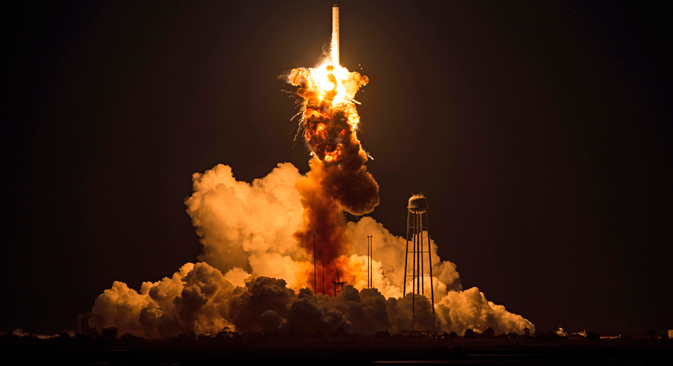
The Orbital Sciences Corporation Antares rocket, with the Cygnus spacecraft onboard suffers a catastrophic anomaly moments after launch from the Mid-Atlantic Regional Spaceport Pad 0A, Tuesday, Oct. 28, 2014, at NASA's Wallops Flight Facility in Virginia. Source: AP
The U.S. plans to discontinue the use of Russian RD-180 engines. They are currently being used by the United Launch Alliance (ULA) company in its Atlas V carrier rockets. The decision was passed by the U.S. Congress in early December 2014.
The need to develop a new U.S. engine has been discussed over the previous decade. The drastic deterioration in U.S.-Russian relations over the conflict in Ukraine has further spurred American politicians’ desire to end dependence on Russian supplies.
Senator John McCain demanded that the U.S. Department of Defense immediately end its cooperation with companies that purchase Russian engines. However, the Committee on Armed Services concluded that the move could threaten U.S. national security.
That is why the ULA was permitted to continue using Russian engines until 2019, when an American replacement is scheduled to be ready. The U.S. will have to spend over $577 billion to develop a new engine. According to a recent piece in Fortune, there are no strong players on the American market at the moment able to create a competitive equivalent.
Russian experts point out that this decision might destroy a whole segment of the market since the RD-180 engine was specifically designed for U.S. rockets. “There is a close link between an engine and a carrier rocket,” says Ivan Moiseyev, head of the Space Policy Institute.
“In order to use the RD-180 in Russia or China, it would be necessary to design a launch system that would meet each country’s specific characteristics. So far, there are no projects like that.”
The world’s best engine?
The RD-180 is manufactured at the Energomash plant in the town of Khimki in Moscow Region. These engines have been used by the ULA consortium, set up by Boeing and Lockheed Martin, to power the first stage of the Atlas V launch vehicle for a long time. The latter is used to launch both civilian and military satellites commissioned by the Pentagon.
According to Moiseyev, the RD-180 is one of the world’s best engines in its class. It was designed on the basis of the RD-170 engine that was used to power the Energia and Zenit carrier rockets. “Modern liquid-fuelled rocket engines have reached their theoretical limit in terms of efficiency,” says Moiseyev.
“The RD-180 uses the most advanced, so-called ‘closed’ engine configuration, very high chamber pressure. After 57 successful launches, the RD-180 has demonstrated 100-percent reliability.”
In addition, according to experts, the RD-180 remains the best engine in terms of value. Energomash told RBTH that before 2010, RD-180 engines were sold to Americans at a loss. However, in 2010-2011 the plant started turning a profit, which allowed Energomash to spend some of the revenues to develop its production facilities.
Under a contract with the United States Air Force, the ULA must carry out 38 launches before 2020. Eight of them have been carried out this year. The company has 16 more RD-180 engines left. According to Alexander Zheleznyakov, an academic with the Russian Academy of Cosmonautics named for Tsiolkovsky, this was mutually beneficial as it had a positive effect on space exploration globally.
“The Americans have been using our RD-180 engines for many years and there have never been any complaints,” says Zheleznyakov. “They are making an essential economic and financial contribution to the ISS program.”
Competition, monopolies and joint ventures
RD-180 engines are used only by American launch vehicles and the discontinuation of supplies will hit Energomash hard, Moiseyev points out. “Most likely, Energomash will have to cut its staff considerably and seek budget financing or subsidies to cope with the higher prices,” says Moiseyev. He adds that Russia is using the RD-170 and the single-chamber RD-191 for its Angara launch vehicle.
In 2013, there was a competition for the RD-180 in the U.S. between the ULA and Orbital Sciences, which also wanted to buy the engines for its Antares rocket. The U.S. Federal Trade Commission launched an antimonopoly probe against the ULA, a Boeing and Lockheed Martin joint venture.
The company was suspected of unlawfully preventing its competitors’ access to components supplied by RD Amross, a joint U.S.-Russian venture uniting Energomash and the U.S. company Pratt & Whitney Rocketdyne. The former manufactures RD-180 engines, while the latter supplies them to the ULA for Atlas V launch systems.
Orbital Sciences had to use liquid-fuelled Aerojet AJ-26 engines, a modification of the old NK-22 engines made by the Samara-based Kuznetsov Design Bureau. They were developed during the Soviet period for the super-heavy N-1 rocket, but the project was closed in the 1970s along with the Soviet lunar program.
In October 2014 an Antares launch vehicle carrying a Cygnus cargo spacecraft that was slated to deliver over two tons of cargo to the ISS exploded at launch. After that Orbital Sciences decided to discontinue the use of any Russian engines. However, on Dec. 10, the company announced that it had signed an official partnership agreement with the ULA: Cygnus spacecraft will be launched with Atlas V carrier rockets fitted with RD-180 engines.
All rights reserved by Rossiyskaya Gazeta.
Subscribe
to our newsletter!
Get the week's best stories straight to your inbox